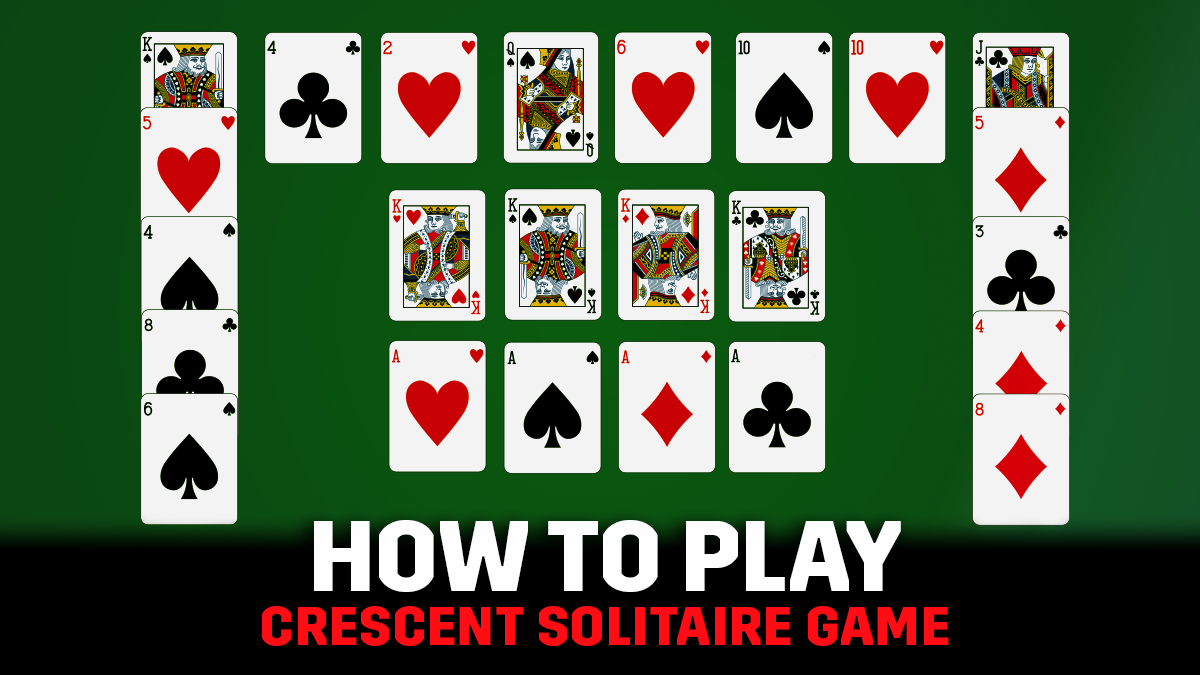Solitaire has been a beloved game for ages now. However, one of the most popular and intriguing games from the same family is Crescent Solitaire.
As the name suggests, the cards in this game are arranged in a crescent shape. This creates a unique and visually appealing layout, which makes it all the more interesting. The goal of the game is to move all the cards to the foundation piles by stacking them in ascending or descending order.
What sets Crescent Solitaire apart is its relaxed pace and strategic thinking.
But how do you play crescent solitaire? Is it the same as classic Solitaire? Here’s everything you must know about this fun solitaire variant. Read ahead to learn all about Crescent Solitaire.
How To Play Crescent Solitaire?

The rules of crescent solitaire online and offline are quite simple; with regular practice, you can ace it.
Objective
In this card game, the objective is to transfer all the cards to the eight designated foundations. Foundations are usually arranged in suits like hearts, diamonds, clubs, and spades. To achieve this goal, you must follow specific rules for moving cards.
Number of Players
Crescent Solitaire is typically a single-player card game. It is designed for individual play, where one person engages with the deck of cards and follows the rules of the game to arrange and organize the cards into the desired sequences. However, it can also be played with two players on online platforms.
Deal
In Crescent Solitaire, the game is played with a total of 104 cards from two decks. The setup consists of eight foundation piles arranged in the middle. These foundation piles are divided into two groups- four are initially dealt a King, and the other four are dealt an Ace. Surrounding these foundation piles are 16 tableau piles.
The remaining cards are distributed among the 16 tableau piles, with each pile receiving six cards. You must then navigate the game by moving and arranging cards within the tableau piles to create ascending or descending sequences and ultimately transferring cards to the foundation piles following the standard rules of the crescent solitaire online and offline game.
Allowed Moves
You are allowed the following moves as per the Crescent solitaire card game rules.
- Only the top card of each tableau pile is accessible for moves
- You can transfer the top card to another tableau pile or to the foundation pile
- You can arrange cards in the tableau pile in ascending or descending order
- Wrapping around is allowed (Ace on King and King on Ace)
- Cards of the same suit, one rank higher or lower, can stack on each other
- Empty tableau spaces are not filled
- If stuck, reshuffling is allowed (up to three times per game)
- You can opt to shuffle again so it moves the bottom card in each tableau stack to the top
- Four foundations, starting with a King, build down in suit
- The other four foundations, starting with an Ace, build up in suit
Tableaus Piles and Foundations
Crescent Solitaire uses two decks of 52 cards each. In the middle of the table are eight foundations, with four foundations of ace and four foundations of kings, of each suit.
You must make moves by stacking cards in ascending order or descending order, creating sequences to eventually move cards to the foundation piles. You cannot stack cards of the same suit together.
The foundations with the kings must be arranged from highest to lowest, and the ones with the aces are the ascending foundations and go from lowest to highest.
The rest of the cards are dealt around these foundations, face up, forming an open rectangle shape with five piles on the left, five piles on the right, and 6 piles connecting them at the top.
Shifting Cards
In Crescent Solitaire, you can strategically shift cards between descending and ascending foundations by suit and in order. For instance, if one of the ascending foundations has K-Q-J-10 and another has A-2-3-4-5-6-7-8-9, you can move the 10 onto the 9 if it is of the same suit.
This tactical move aids efficiency, such as placing a Jack on the ascending sequence to remove it.
However, it’s essential to understand and evaluate the available cards. If a 9 is present without a jack, maintaining the foundations as is may be wiser. This nuanced strategy enhances your ability to move forward in the game, optimizing moves based on the cards in play.
Tips For Winning in Crescent Solitaire

Here are a few tips to play Crescent Solitaire online and offline.
Focus on Foundations
Make it a priority to move cards to the foundation piles with Aces or Kings. This is crucial for building sequences and completing the game successfully.
Build in Order
Arrange cards in ascending or descending order within the tableau. Utilize the wrap-around feature (Ace on King and King on Ace) to create suitable sequences.
Uncover Hidden Cards
As you move cards, you will uncover hidden ones. Try to reveal these hidden cards strategically, as they may open up new possibilities for moves.
Plan Ahead
Anticipate the consequences of your moves. Think ahead and consider the potential outcomes to avoid getting stuck with no valid moves.
Balance Foundations
If possible, try to build on both the ascending and descending foundations simultaneously, whether offline or online crescent solitaire. Balancing progress in both directions can provide more flexibility.
FAQs
Can I win Crescent Solitaire?
Yes, you can win Crescent Solitaire by strategically moving cards to the foundations in the right order. You can successfully complete the online crescent solitaire game with careful planning and smart moves.
What is the hardest game of Solitaire?
Spider Solitaire is often considered one of the hardest versions of Solitaire. Its eight suits and intricate layout pose a greater challenge than traditional Solitaire games. However, playing Crescent Solitaire offers a perfect blend of challenge and fun.


